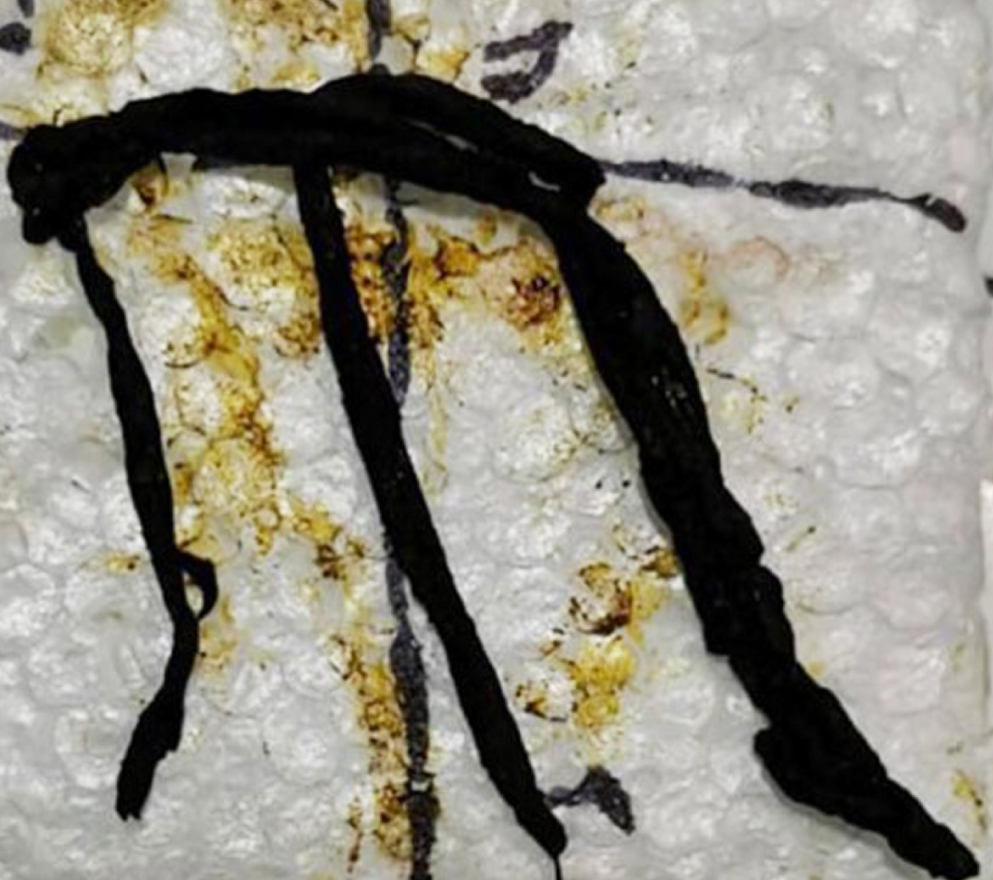Emerging Disease: A Case Series of post-COVID-19 Cholangiopathy
DOI:
https://doi.org/10.22516/25007440.1005Keywords:
Cholangiopathy, SARS-CoV-2, COVID-19, Cholangitis, SepsisAbstract
Introduction: Post-COVID-19 cholangiopathy is a novel condition characterized by biliary tract sclerosis and elevated alkaline phosphatase levels in critically ill patients. This case series aims to describe the experience of a Latin American reference hospital in managing this condition.
Methods: This case series includes patients with confirmed coronavirus disease 2019 (COVID-19) who exhibited subsequent elevation of alkaline phosphatase levels exceeding three times the normal value. The patients also had documented bile duct abnormalities observed through cholangioresonance or endoscopic retrograde cholangiopancreatography (ERCP). The clinical presentation, imaging findings, complications, and treatment approaches are described.
Results: Eight patients (56.5 ± 9.2 years old, 62.5% male) were included in the study. All patients had previously experienced severe acute respiratory syndrome coronavirus type 2 (SARS-CoV-2) pneumonia and required mechanical ventilation. Four patients (50%) received sedoanalgesia with ketamine, and all eight patients (100%) received propofol. All patients developed infections, such as cholangitis or liver abscesses, caused by gram-negative bacteria. The peak alkaline phosphatase level during follow-up averaged 1646.12 ± 611.3. Imaging findings revealed intrahepatic (100%) and extrahepatic (87.5%) bile duct dilation. In 75% of cases, bile molds with a black appearance were extracted. Seven patients experienced recurrent cholangitis, and three patients were referred for pre-liver transplant consultation.
Conclusions: Post-COVID-19 cholangiopathy is characterized by severe cholestasis, intra- and extrahepatic bile duct dilation, formation of bile molds, and recurrent cholangitis. In our study, a possible association between sepsis caused by gram-negative bacteria and the use of sedative medications is hypothesized. Further studies are necessary to establish the most appropriate management strategies for these patients, as they currently face unfavorable long-term morbidity and mortality outcomes.
Downloads
References
Wang D, Hu B, Hu C, Zhu F, Liu X, Zhang J, et al. Clinical Characteristics of 138 Hospitalized Patients with 2019 Novel Coronavirus-Infected Pneumonia in Wuhan, China. JAMA. 2020;323(11):1061-1069. https://doi.org/10.1001/jama.2020.1585
Sultan S, Altayar O, Siddique SM, Davitkov P, Feuerstein JD, Lim JK, et al. AGA Institute Rapid Review of the Gastrointestinal and Liver Patients with COVID-19. 2020;159(1):320-334.e27. https://doi.org/10.1053/j.gastro.2020.05.001
Fan Z, Chen L, Li J, Cheng X, Yang J, Tian C, et al. Pancreas, biliary tract, and liver Clinical Features of COVID-19-Related Liver Functional Abnormality. Clin Gastroenterol Hepatol. 2020;18(7):1561-1566. https://doi.org/10.1016/j.cgh.2020.04.002
Roth NC, Kim A, Vitkovski T, Xia J, Ramirez G, Bernstein D, et al. Post-COVID-19 Cholangiopathy: A Novel Entity. Am J Gastroenterol. 2021;116(5):1077-1082. https://doi.org/10.14309/ajg.0000000000001154
Faruqui S, Okoli FC, Olsen SK, Feldman DM, Kalia HS, Park JS, et al. Cholangiopathy after severe COVID-19: Clinical features and prognostic implications. Am J Gastroenterol. 2021;116(7):1414-1425. https://doi.org/10.14309/ajg.0000000000001264
Bryce C, Grimes Z, Pujadas E, Ahuja S, Beasley MB, Albrecht R, et al. Pathophysiology of SARS-CoV-2: Targeting of endothelial cells renders a complex disease with thrombotic microangiopathy and aberrant immune response. The Mount Sinai COVID-19 autopsy experience. medRxiv. 2020. https://doi.org/10.1101/2020.05.18.20099960
Meersseman P, Blondeel J, De Vlieger G, et al. Secondary sclerosing cholangitis: an emerging complication in critically ill COVID-19 patients. Intensive Care Med. 2021;47(9):1037-1040. https://doi.org/10.1007/s00134-021-06445-8
Lin T, Qu K, Xu X, van der Merwe S, Monbaliu D; Collaborators Leuven Liver Transplant program. Sclerosing cholangitis in critically ill patients: An important and easily ignored problem based on a German experience. Front Med China. 2014;8(1):118-126. https://doi.org/10.1007/s11684-014-0306-6
Laurent L, Lemaitre C, Minello A, Plessier A, Lamblin G, Poujol-Robert A, et al. Cholangiopathy in critically ill patients surviving beyond the intensive care period: a multicentre survey in liver units. Aliment Pharmacol Ther. 2017;46(11-12):1070-1076. https://doi.org/10.1111/apt.14367
Martins P, Verdelho Machado M. Secondary Sclerosing Cholangitis in Critically Ill Patients: An Underdiagnosed Entity. GE Port J Gastroenterol. 2020;27(2):103-114. https://doi.org/10.1159/000501405
Leonhardt S, Veltzke-Schlieker W, Adler A, Schott E, Hetzer R, Schaffartzik W, et al. Trigger mechanisms of secondary sclerosing cholangitis in critically ill patients. Crit Care. 2015;19(1):131. https://doi.org/10.1186/s13054-015-0861-5
Bressler B, Yarur A, Kopylov U, Bassel M, Brett N, Lissoos T, et al. Clinical Effectiveness of First-Line Anti-TNF Therapies and Second-Line Anti-TNF Therapy Post-Vedolizumab Discontinuation in Patients With Ulcerative Colitis or Crohn’s Disease. Am J Gastroenterol. 2019;114:s373. https://doi.org/10.14309/01.ajg.0000592088.78600.39
Song D, Geetha HS, Kim A, Seen T, Almas T, Nagarajan VR, et al. Transformation of acute cholecystitis to acute choledocholithiasis in COVID-19 patient. Ann Med Surg. 2021;71:102946. https://doi.org/10.1016/j.amsu.2021.102946
Zhou P, Yang XL, Wang XG, Hu B, Zhang L, Zhang W, et al. A pneumonia outbreak associated with a new coronavirus of probable bat origin. Nature. 2020;579(7798):270-273. https://doi.org/10.1038/s41586-020-2012-7
Chai X, Hu L, Zhang Y, Han W, Lu Z, Ke A, et al. Specific ACE2 expression in cholangiocytes may cause liver damage after 2019-nCoV infection. bioRxiv. 2020. https://doi.org/10.1101/2020.02.03.931766.
Peña-Pérez CA, Díaz Ponce-Medrano JA. Colangitis esclerosante secundaria en pacientes críticamente enfermos. Cir Cir. 2018;86(1):56-62. https://doi.org/10.24875/CIRU.M18000003
Yu WL, Cho CC, Lung PF, Hung EH, Hui JW, Chau HH, et al. Ketamine-related cholangiopathy: a retrospective study on clinical and imaging findings. Abdom Imaging. 2014;39(6):1241-1246. https://doi.org/10.1007/s00261-014-0173-2
Keta-Cov research group. Intravenous ketamine and progressive cholangiopathy in COVID-19 patients. J Hepatol. 2021;74(5):1243-1244. https://doi.org/10.1016/j.jhep.2021.02.007
Seto WK, Mak SK, Chiu K, Vardhanabhuti V, Wong HF, Leong HT, et al. Magnetic resonance cholangiogram patterns and clinical profiles of ketamine-related cholangiopathy in drug users. J Hepatol. 2018;69(1):121-128. https://doi.org/10.1016/j.jhep.2018.03.006
Lindor KD, Bowlus CL, Boyer J, Levy C, Mayo M. Primary Biliary Cholangitis: 2018 Practice Guidance from the American Association for the Study of Liver Diseases. Hepatology. 2019;69(1):394-419. https://doi.org/10.1002/hep.30145

Downloads
Published
How to Cite
Issue
Section
License
Copyright (c) 2023 Revista colombiana de Gastroenterología

This work is licensed under a Creative Commons Attribution-NonCommercial-NoDerivatives 4.0 International License.
Aquellos autores/as que tengan publicaciones con esta revista, aceptan los términos siguientes:
Los autores/as ceden sus derechos de autor y garantizarán a la revista el derecho de primera publicación de su obra, el cuál estará simultáneamente sujeto a la Licencia de reconocimiento de Creative Commons que permite a terceros compartir la obra siempre que se indique su autor y su primera publicación en esta revista.
Los contenidos están protegidos bajo una licencia de Creative Commons Reconocimiento-NoComercial-SinObraDerivada 4.0 Internacional.


| Article metrics | |
|---|---|
| Abstract views | |
| Galley vies | |
| PDF Views | |
| HTML views | |
| Other views | |














